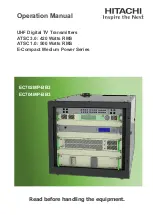
Ridge Tool Company
●
Elyria, Ohio
●
U.S.A
www.seektech.com
11
SeekTech ST-305 Line Transmitter
Inductive Clamp Method
Figure 9: ST-305 with Inductive Clamp
When using an inductive clamp, plug the inductive
clamp jack into the receptacle provided at the end of
the transmitter. The Inductive Mode LED will flash
rapidly when a clamp is connected. Clips and leads
are not used. Note that for a clear signal using an
inductive clamp, both ends of the utility should be
grounded.
Clamp the inductive clamp around an accessible
portion of the line chosen to trace. The clamp will
induce a signal into the conductor when the
transmitter is powered on.
Select frequency and power as with the Direct
Connect Method. Operational frequency choices for
use with an Inductive Clamp are 1 kHz, 8 kHz, and
33 kHz.
Figure 10: Inductive Clamp Attached to a Conductor
Inductive Mode
1. Be sure that the transmitter is positioned
correctly over the line.
Figure 11: Orientation to the Line – Inductive Mode
Note:
A slight tilt to the axis of the conductor can
help reduce the probability of air-coupling (see
page 12):
Transmitter
Conductor
2. Power the transmitter on. Push the Inductive
Mode switch to induce a signal onto the line
without a direct connection. (A long beep will
sound when entering Inductive Mode.) The
Inductive Mode LED will light .
3. Clips and leads are not used. Note that for a
clear signal using induction, both ends of the
utility should be grounded.
4. The transmitter will emit a series of regular
beeps as long as it is in Inductive Mode.
Orientation
Guide




































